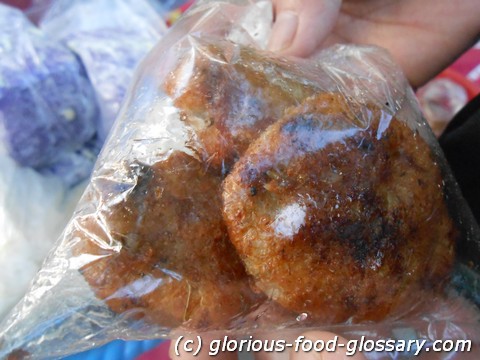English: Rice Cake / Deutsch: Reiskuchen / Español: Torta de arroz / Português: Bolo de arroz / Français: Gâteau de riz / Italiano: Torta di riso /
In the food context, "Buchi" is a popular Filipino dessert made from glutinous rice flour filled with a sweetened mung bean paste, and then coated in sesame seeds and deep-fried until golden brown. It is a variation of the Chinese "jian dui" and is known for its chewy texture, sweet filling, and crispy sesame-coated exterior. Buchi is often served in Chinese-Filipino restaurants and is a common snack or dessert in the Philippines.
Preparation and Ingredients:
The basic ingredients for Buchi include:
- Glutinous Rice Flour: Forms the dough and gives Buchi its characteristic chewy texture.
- Mung Bean Paste: A sweet filling made from cooked, mashed mung beans mixed with sugar. Some variations may use sweetened red bean paste, ube (purple yam) jam, or even custard as a filling.
- Sesame Seeds: The dough balls are rolled in sesame seeds before frying, which adds a nutty flavor and a crunchy texture.
- Cooking Oil: For deep-frying the Buchi until they are golden brown and crispy.
Cooking Process:
- Making the Filling: Mung beans are cooked, mashed, and mixed with sugar to form a sweet paste.
- Preparing the Dough: Glutinous rice flour is mixed with water to form a dough.
- Assembling the Buchi: Small portions of dough are flattened, filled with the sweet bean paste, and then shaped into balls. These balls are then rolled in sesame seeds.
- Deep-Frying: The coated balls are deep-fried in hot oil until they expand slightly and turn golden brown, ensuring a crispy exterior and a soft, chewy interior.
Serving:
Buchi is typically served warm or at room temperature as a dessert or snack. It's not uncommon to find Buchi as part of the dessert offerings at Filipino gatherings and celebrations.
Nutritional Information:
While Buchi offers some nutritional benefits from the mung beans, such as protein and fiber, it is also relatively high in calories due to the sugar content and deep-frying process. Enjoying Buchi in moderation is advisable as part of a balanced diet.
Articles with 'Buchi' in the title
- Butsi / Buchi: Butsi / Buchi: Butsi is the Filipino term for sweet snack made of sesame rice cakes filled with bean paste
Summary
Buchi is a beloved Filipino dessert that showcases the influence of Chinese cuisine on Filipino culinary traditions. Its combination of sweet filling, chewy texture, and crispy sesame seed coating makes it a delightful treat enjoyed by people of all ages. Whether as a dessert or snack, Buchi is a testament to the simple yet satisfying flavors that characterize Filipino sweets.
--
Referred Picture:

Related Articles to the term 'Buchi' | |
| 'Ham Chim Peng' | ■■■■■■■■■■ |
| Ham Chim Peng refers to a sweet flat and round dough made of flour and yeast. Ham Chim Peng is available . . . Read More | |
| 'Pritong Kamote' | ■■■■■■■■■■ |
| Pritong Kamote refers to fried sweet potatoes in Filipino cuisine, a popular snack or side dish that . . . Read More | |
| 'Maruya' | ■■■■■■■■■■ |
| Maruya is a traditional Filipino snack made from bananas, typically Saba bananas, which are battered . . . Read More | |
| 'Zhimaqiu' | ■■■■■■■■■■ |
| Zhimaqiu are \'Sesame Balls\'. . . . . . . Read More | |
| 'Kapet' | ■■■■■■■■■ |
| Kapet is an Ilocano dish which is made of glutinous rice. It is similar to Tikoy or a Tikoy itself, but . . . Read More | |
| 'Squid Balls' | ■■■■■■■■■ |
| Squid Balls are a popular street food and culinary ingredient in various Asian cuisines, including Chinese, . . . Read More | |
| 'Mantou' | ■■■■■■■■■ |
| Mantou in the food context refers to a type of steamed bun or Bread popular in Chinese cuisine. It is . . . Read More | |
| 'Manju' | ■■■■■■■■■ |
| Manju is a popular Japanese confection traditionally made from flour, rice powder, and buckwheat and . . . Read More | |
| 'Amagwinya' | ■■■■■■■■ |
| Amagwinya also known as Vetkoek refers to a popular traditional Zulu food which is flour mixture with . . . Read More | |
| 'Eu Char Koay' | ■■■■■■■■ |
| Eu Char Koay refers to Chinese cruller or fried dough which is one of the hawkers food found in Penang . . . Read More | |
